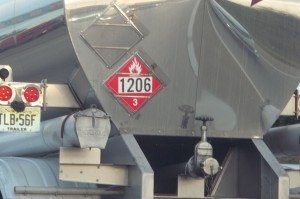Anyone who travels the nation’s highways will see hazardous materials (HazMat) transported in commerce by some form of a motor vehicle. If in large quantities, like 5,000 gallons or more, the form of transportation will be a large tractor & semi-trailer combination vehicle. A hazardous material in transportation by motor vehicle is easily identified by the presence of placards on the vehicle (that’s assuming that the type and amount of HazMat mandates placarding and that, if required, the driver has placarded the vehicle properly). But let’s just assume that the motor vehicle you see transporting HazMat is correctly displaying each of the hazard communication methods required by the Hazardous Material Regulations (HMR) of the PHMSA/USDOT; what then? With the right information, you can detect the presence and decipher the meaning of the hazard communication methods used. The purpose of this article is to provide that information.On a recent trip to Columbus, OH for a Training Seminar I saw the following:
Before I discuss the two different kinds of hazardous materials represented in these photos, I’ll point out some of the things they both have in common.
First, they are both motor vehicles (defined at 49 CFR 171.8 as):
Motor vehicle includes a vehicle, machine, tractor, trailer, or semitrailer, or any combination thereof, propelled or drawn by mechanical power and used upon the highways in the transportation of passengers or property. It does not include a vehicle, locomotive, or car operated exclusively on a rail or rails, or a trolley bus operated by electric power derived from a fixed overhead wire, furnishing local passenger transportation similar to street-railway service.
So, a motor vehicle is almost anything used to transport passengers or property on the highway. Specifically excluded are trains and electric trolleys. Defined elsewhere – and therefore not a motor vehicle – are aircraft and vessels.
Secondly, in both cases the hazardous material is contained in a cargo tank (also defined at 49 CFR 171.8):
Cargo tank means a bulk packaging that:
(1) Is a tank intended primarily for the carriage of liquids or gases and includes appurtenances, reinforcements, fittings, and closures (for the definition of a tank, see 49 CFR 178.320, 178.337-1, or 178.338-1, as applicable);
(2) Is permanently attached to or forms a part of a motor vehicle, or is not permanently attached to a motor vehicle but which, by reason of its size, construction or attachment to a motor vehicle is loaded or unloaded without being removed from the motor vehicle; and
(3) Is not fabricated under a specification for cylinders, intermediate bulk containers, multi-unit tank car tanks, portable tanks, or tank cars.
Daniels Training Services 815.821.1550 |
A cargo tank is a bulk packaging (read: Bulk Packaging for HazMat Explained!), meant primarily for liquids and gases (though solids aren’t specifically excluded), is permanently attached to the motor vehicle (or is attached in a way so that it is not removed from the vehicle for loading and unloading), and is not one of the packagings listed in paragraph (3) of the definition.
Put “Motor Vehicle” and “Cargo Tank” together and you’ve got “Cargo Tank Motor Vehicle” which (you guessed it!) is defined at 49 CFR 171.8:
Cargo tank motor vehicle means a motor vehicle with one or more cargo tanks permanently attached to or forming an integral part of the motor vehicle.
Continuing with the similarities, both cargo tank motor vehicles are displaying the Hazard Class 3 Flammable Liquid placard on each side and each end, ie. all four sides of the cargo tank.
The placard uses colors (red), an internationally recognized symbol for fire, and the Hazard Class number (3 in the bottom point). The placard is designed to be seen from a distance and therefore the HMR has specific regulations for its size and how it must be displayed. The fact that the HazMat is a Class 3 Flammable Liquid transported in a cargo tank like this allows us to make the assumption that this material is hazardous because its flash point is at or below 60°C (140°F). It’s possible that the HazMat is a flammable liquid for some other reason, eg. it’s a liquid with a flash point ≥37.8 °C (100 °F) that is intentionally heated and offered for transportation or transported at or above its flash point, but I’m sticking with my original assumption.
Like this article? Subscribe to my Monthly Newsletter No marketing emails! |
It’s here at a cargo tank motor vehicle of a Flammable Liquid (flash point ≤140°F) that our two HazMats part ways. The obvious indicator of the distinction is the four digit Identification Number visible big and bold in the middle of each placard. The Identification Number tells us the following:
- UN1206 corresponds to proper shipping name: Heptanes
- UN1866 corresponds to proper shipping name: Resin solutions


Determining the proper shipping name from the Identification Number can be done by skimming the entire Hazardous Materials Table (a tedious task) or it can be accomplished much faster if you refer to the ID Cross Reference Table in the Hazardous Materials Compliance Pocketbook published by J.J. Keller. Double check this information with the Hazardous Materials Table at 49 CFR 172.101 and you’ve got it.
That’s about all I can discern from these images. Do you see something I missed?
Keep your eyes open on the highway and you’ll see a lot of HazMat moving to and fro. Read and understand the hazard communication methods: shipping papers, placards, labels, & markings; and you’ll have some idea of the potential hazards. If you want to learn more, contact me for a free training consultation.
Training Services I provide for HazMat Employees & Hazardous Waste Personnel: |
Postscript: The drivers of these two motor vehicle performed brilliantly! At no time did I see them exceed the speed limit or drive in an unsafe manner. They are to be commended for their professionalism and the good image they projected for their respective employers.
